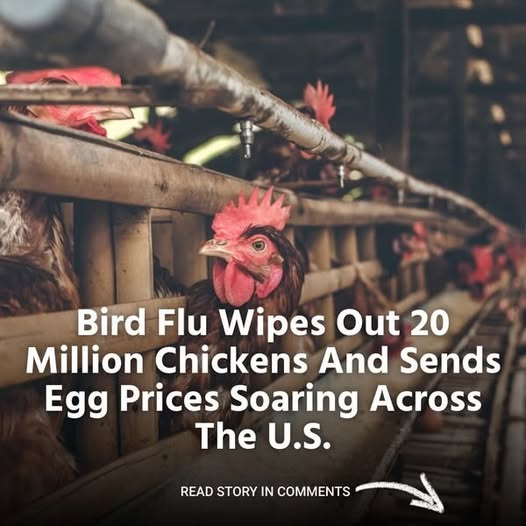The United States is currently facing a major crisis in egg production due to a devastating outbreak of avian flu. Over 20 million egg-laying chickens have been culled in an effort to contain the virus, leading to a nationwide shortage and causing egg prices to surge. The scale of this outbreak and its immediate impact on the market have highlighted just how fragile the food supply chain can be, leaving consumers frustrated and businesses struggling to adapt.

The Devastating Impact of Avian Flu
Avian flu, also known as highly pathogenic avian influenza (HPAI), is a deadly virus that spreads rapidly among poultry. Once an infection is detected in a flock, the standard response is to cull all birds in the affected area to prevent further transmission. While this approach is necessary to contain the outbreak, it has led to the loss of millions of egg-laying hens, severely disrupting the country’s egg supply.
According to the U.S. Department of Agriculture (USDA), the outbreak has affected all major egg production systems, forcing farms to halt operations and implement strict biosecurity measures. The resulting shortage has driven up prices, making eggs an increasingly expensive staple for American households.
Why Are Egg Prices So Sensitive to Supply Changes?
The egg market is particularly vulnerable to supply disruptions because egg production operates on a continuous cycle. Unlike other agricultural products that can be stored for long periods, eggs have a limited shelf life, meaning any reduction in production leads to immediate shortages.
In a normal market, supply and demand maintain a relatively stable balance. However, when millions of egg-laying chickens are removed from the system within weeks, supply plummets while demand remains the same. This sudden imbalance forces prices to rise sharply, and recovery can take months or even years.
Additionally, replacing lost flocks is not an overnight process. After a farm experiences an outbreak, it must undergo extensive cleaning and disinfection before introducing new birds. Even then, it takes several months for young hens to reach maturity and start laying eggs. These delays keep prices elevated long after the initial outbreak has subsided.
The Effect on Consumers and Businesses
For everyday consumers, the rise in egg prices has become a major frustration. Grocery store shelves are still stocked with eggs, but they come at a much higher cost than before. Some households are cutting back on egg consumption, while others are looking for alternatives such as plant-based egg substitutes or local farms with smaller-scale production.
Businesses that rely on eggs, including bakeries, restaurants, and food manufacturers, are also feeling the strain. Many have had to adjust their pricing, pass costs onto customers, or modify recipes to use fewer eggs. The economic impact extends beyond the grocery aisle, affecting the entire food service industry.
How the USDA and Poultry Industry Are Responding
The USDA is actively working to contain the outbreak and minimize further losses. Officials have emphasized the importance of biosecurity measures, urging poultry farmers to limit exposure to wild birds, sanitize equipment, and closely monitor their flocks for signs of infection.
Despite these efforts, controlling avian flu remains a significant challenge. The virus is primarily spread by wild birds, making it difficult to prevent entirely. Even with strict protocols in place, outbreaks can still occur, leading to continued disruptions in egg production.
The Bigger Picture: A Fragile Food Supply Chain
This crisis has exposed weaknesses in the U.S. food supply chain, showing just how vulnerable essential products like eggs can be to sudden shocks. While food production in the country is generally reliable, events like disease outbreaks, extreme weather, and supply chain disruptions can have widespread consequences.
Experts argue that more investment is needed in disease prevention strategies, such as developing better vaccines for poultry and implementing stronger biosecurity measures. Others suggest diversifying egg production by supporting local farms and reducing reliance on large factory operations.
What to Expect Moving Forward
Egg prices are expected to remain high for the foreseeable future as the poultry industry works to recover. Restoring production levels will take time, and consumers should be prepared for continued price fluctuations. Some analysts predict that prices will stabilize within six to twelve months, but this depends on whether the outbreak is fully contained.
For now, consumers will need to navigate rising costs, explore alternatives, and stay informed about the evolving situation. While this crisis highlights the unpredictability of food production, it also underscores the need for long-term solutions to prevent similar disruptions in the future.
Final Thoughts
The bird flu outbreak has revealed just how fragile the U.S. egg supply chain is, with the loss of 20 million egg-laying chickens sending shockwaves through the market. Prices have surged, impacting both consumers and businesses, and recovery will take time.
As efforts to control the outbreak continue, policymakers and industry leaders must find ways to build a more resilient food system—one that can withstand challenges like this without creating major price spikes. Until then, Americans will have to adjust to the reality of higher egg prices and ongoing uncertainty in the market.





